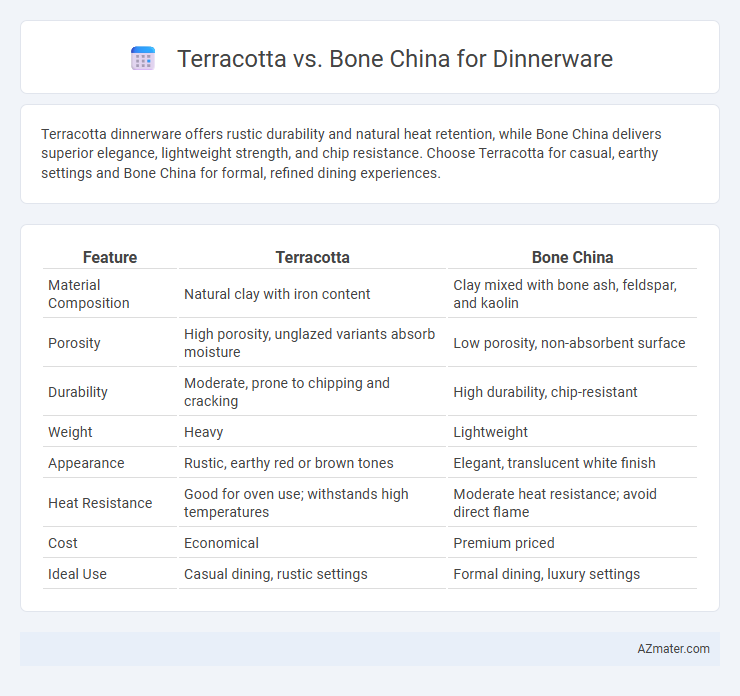Terracotta dinnerware offers rustic durability and natural heat retention, while Bone China delivers superior elegance, lightweight strength, and chip resistance. Choose Terracotta for casual, earthy settings and Bone China for formal, refined dining experiences.
Table of Comparison
| Feature | Terracotta | Bone China |
|---|---|---|
| Material Composition | Natural clay with iron content | Clay mixed with bone ash, feldspar, and kaolin |
| Porosity | High porosity, unglazed variants absorb moisture | Low porosity, non-absorbent surface |
| Durability | Moderate, prone to chipping and cracking | High durability, chip-resistant |
| Weight | Heavy | Lightweight |
| Appearance | Rustic, earthy red or brown tones | Elegant, translucent white finish |
| Heat Resistance | Good for oven use; withstands high temperatures | Moderate heat resistance; avoid direct flame |
| Cost | Economical | Premium priced |
| Ideal Use | Casual dining, rustic settings | Formal dining, luxury settings |
Introduction to Terracotta and Bone China Dinnerware
Terracotta dinnerware, made from natural clay fired at lower temperatures, offers a rustic, earthy aesthetic with excellent heat retention and durability, ideal for casual dining. Bone China dinnerware, composed of fine china clay mixed with bone ash, is renowned for its lightweight, translucent quality, and exceptional strength, making it a premium choice for formal table settings. Both materials provide distinct tactile and visual experiences, catering to different dining atmospheres and preferences for elegance or natural charm.
Material Composition: Terracotta vs Bone China
Terracotta dinnerware is crafted from porous clay that is fired at low temperatures, resulting in a sturdy, rustic material with natural earthy tones but less translucency and chip resistance. Bone china, composed of bone ash, kaolin, and feldspar, undergoes high-temperature firing to achieve a durable, lightweight, and translucent quality with superior strength and a smooth, refined finish. The mineral composition of bone china provides enhanced whiteness and chip resistance compared to the more porous and matte surface of terracotta.
Aesthetic Appeal and Design Variations
Terracotta dinnerware offers a rustic, earthy aesthetic with warm, natural hues and textured surfaces that evoke a handcrafted charm, often featuring matte finishes and organic shapes. Bone china provides a refined, elegant appeal with a smooth, translucent quality and delicate designs, including floral patterns and intricate detailing that enhance formal dining settings. Design variations in terracotta often emphasize artisanal uniqueness and durability, while bone china focuses on sophistication, lightness, and traditional or contemporary motifs.
Durability and Strength Compared
Terracotta dinnerware is porous and more prone to chipping or cracking under thermal stress, making it less durable than bone china. Bone china demonstrates superior strength due to its high levels of calcium phosphate and feldspar, providing excellent resistance to chipping and thermal shock. For long-lasting dinnerware, bone china is preferred for its enhanced durability and mechanical strength compared to terracotta.
Weight and Handling Differences
Terracotta dinnerware is generally heavier and sturdier compared to bone china, which is known for its lightweight and delicate feel. The porous nature of terracotta adds to its bulk, making it less convenient for frequent handling but ideal for rustic, casual dining. Bone china's smooth, thin composition offers ease of use and elegant presentation, especially preferred in formal settings requiring lighter tableware.
Heat Retention and Thermal Properties
Terracotta dinnerware excels in heat retention due to its porous structure, which allows it to absorb and evenly distribute heat, making it ideal for keeping food warm longer. Bone china, while elegant and durable, has lower thermal mass and cools down faster, reducing its effectiveness in maintaining meal temperatures. The denser composition of bone china also means it heats up and cools down quickly, whereas terracotta's insulating properties provide superior thermal stability for hot dishes.
Suitability for Everyday Use and Special Occasions
Terracotta dinnerware offers durability and rustic charm, making it suitable for everyday use due to its resistance to chipping and ease of cleaning. Bone china, known for its delicate translucency and refined appearance, is ideal for special occasions, providing an elegant dining experience that enhances formal settings. While bone china requires careful handling, terracotta withstands frequent use and adds a natural aesthetic to casual meals.
Care, Maintenance, and Dishwasher Safety
Terracotta dinnerware requires gentle hand washing to prevent cracks and damage, as it is porous and absorbs water, making it unsuitable for dishwasher use. Bone china offers greater durability and is typically dishwasher safe, but care should be taken to avoid harsh detergents and rapid temperature changes to maintain its enamel finish. Proper maintenance of each material ensures longevity, with terracotta benefiting from occasional sealing and bone china requiring careful handling to prevent chipping.
Environmental Impact and Sustainability
Terracotta dinnerware is often more environmentally sustainable due to its natural clay composition and lower energy requirements during firing compared to bone china, which involves intensive processing and the use of animal bone ash. Terracotta's biodegradability and local sourcing contribute to a reduced carbon footprint, while bone china production has higher emissions and relies on finite resources. Choosing terracotta supports eco-friendly practices by minimizing waste and promoting renewable materials in dinnerware manufacturing.
Price Range and Value for Money
Terracotta dinnerware typically falls within a lower price range, making it an affordable option for everyday use while offering durability and a rustic aesthetic. Bone china, though more expensive due to its refined materials and craftsmanship, provides superior strength, translucency, and an elegant finish that enhances formal dining experiences. Choosing between the two depends on budget constraints and the desired balance between cost efficiency and sophisticated presentation.

Infographic: Terracotta vs Bone China for Dinnerware
 azmater.com
azmater.com